|
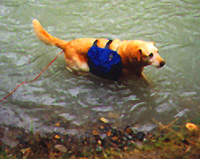
"The Chilkoot Trail is difficult, even dangerous, to
those not possessed of steady nerve"
Henry De Windt, 1897 |
|
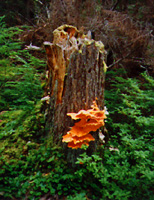
|
Fascinating fungi
find a home on dead tree stumps. |
|
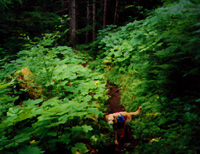
| Rain is a frequent companion to the Chilkoot Trail
hiker. But with it comes the blessing of lush green rain forest,
filled with mosses, mushrooms and delicate ferns. |
|
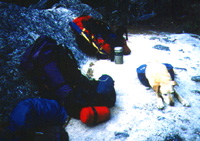
| Although it is no longer mandatory to carry a"ton
of goods" as in the Gold Rush days, the trail is still quite difficult.
Expect 3 to 5 days to make the trip. Do not overestimate your abilities! |
|
|
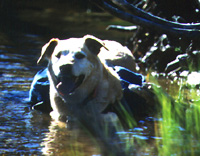
| Expect many stream crossings. Although there
are many good bridges, at times the water is quite high. An unexpected
swim should be anticipated. Be sure to pack with a waterproof system.
|
|
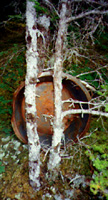
| Hikers are constantly reminded of the trail's colorful
history by ever present Gold Rush artifacts along the way. |
|

| In
Canyon City, near the trail, this huge boiler from the Dyea Klondike and Transportation company still can be seen. |
|
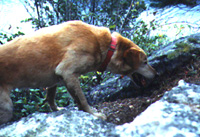
| The "Golden Stairs" is a 45 degree climb from the
Scales to the summit of Chilkoot Pass. This is the most challenging
part of the trip. It is a rock scramble that seems virtually endless.
It is not unusual to combine this climb with high winds, rain, sleet or
even snow. |
|
|
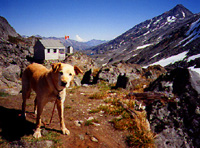
|
But the view from the summit as man, beast, or
early stampeder crosses into Canada, makes the struggle well worth the
effort. It's a great place to take a much needed break. This place is more beautiful than all the gold in
the Klondike!
|
|
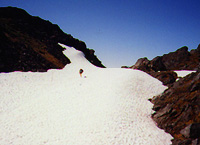
| One is reminded of the struggling stampeders as
the tiny dots of fellow hikers are seen dropping over the pass onto the
summit snow field. It's difficult to imagine that the stampeders
had to make as many as 30 trips over this route to ferry their "ton of
goods" over the pass. |
|
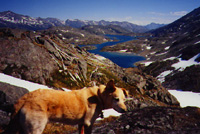
| After a peaceful rest at the summit, the trek continues
down from the pass to the right of Crater Lake across snow fields, and
creeks, to Happy Camp, Deep Lake camp, and Lindeman City. Lindeman
City was once a townsite of 4000. But most of the former residents
lived in tents. By fall 1899, it was deserted. |
|
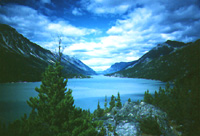
| In summer 1898, Lindeman Lake was used by barges
and even a small steamer, to carry gold rush supplies and stampeders across
the lake. In winter it became a frozen highway to the town of Bennett. Many artifacts remain from the former tent city
of Lindeman. It is a fascinating place to explore. |
|
|

| A 100 year old bone seems to have little appeal! |
|

| However, Bare Loon Lake was like a gift from God!
After hiking for many hours in the hot sun, a refreshing swim in Bare Loon
Lake is awesome! |
|

| This little trapper's cabin sits comfortably beside
the trail. It's a welcome rest stop before the hot and sandy walk
to the final destination of Bennett. |
|
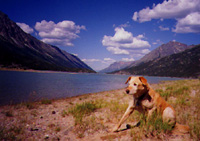
| Beautiful Bennett is a welcome sight and a lovely
place to make the final camp. Bennett is the end of the line for
today's hikers. From there one can take the train back to Skagway
or hike out 9 miles to the road at Log Cabin. |
|